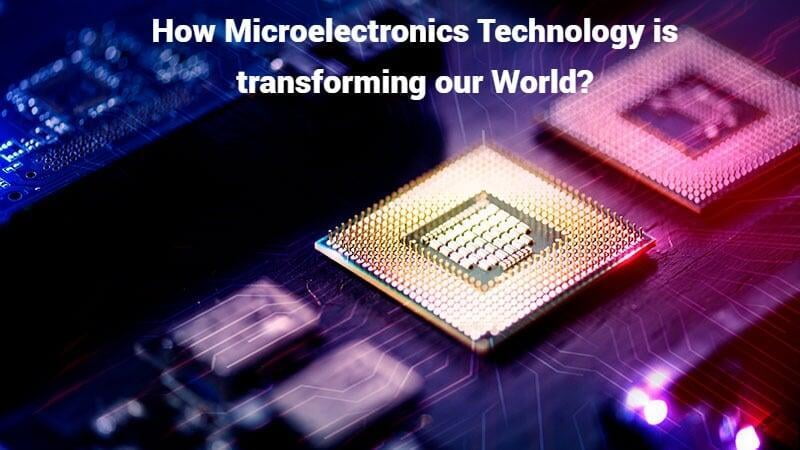
In our day to day life we can clearly experience the technology we are depending on and their rapid advancements, with each advancement in technology our life is getting more easier. And now the Microelectronics field has revolutionized the way we live, work, and interact with the world around us. There’s a huge number of applications that come with microelectronics. From developing smaller and more efficient electronic components to creating powerful robots, smart homes, smartphones, wearable devices, etc, the potential applications of this technology are seemingly endless. This article will explore how microelectronics transforms our world and unlocks a new era of possibilities.
What are Microelectronics?
Advantages of Microelectronics
Reduced Size: Microelectronics enables the structure of devices that are significantly smaller than traditional electronic devices, which offers the benefit of compactness in circuit design.
Increased Speed: Microelectronic devices operate at higher speeds due to reduced distances required for electrical signals to travel, resulting in faster performance.
Improved Energy Efficiency: Microelectronics encourages the development of devices that are more energy efficient.
Commonly Used Microelectronic Devices
Microprocessors: Microelectronics is the main building part of Microprocessors, which has now vast use in Embedded and IOT applications.
Sensors: Microelectronic sensors find widespread applications in fields such as consumer electronics, medical devices, automotive systems, and military systems.
Actuators:Actuators, another class of microelectronic devices, play vital roles in converting electrical signals into physical actions or movements.
Memory Devices: Microelectronic memory devices are utilized extensively in diverse domains, ranging from consumer electronics to industrial systems.
What are the Challenges in the Field of Microelectronics?
Performance Enhancement: A significant challenge in microelectronics is to continuously improve the performance and capabilities of microelectronic devices while simultaneously reducing their size and cost.
Advanced Simulations and Testing: The field of microelectronics relies on advanced computer simulations and testing methods to ensure the functionality and reliability of devices.
Technological Innovation: The ever-evolving microelectronics demands constant technological innovation to stay at the forefront of advancements in the industry.
How Microelectronics are Transforming Our World?
Use of Microelectronics in the Internet of Things
Uses and applications of IOT are increasing day by day. The Internet of Things is a network of physical objects connected to the internet. This includes everything from our smartphone to our homes, Which is possible because of microprocessors. These tiny devices allow these objects to connect to the internet and communicate with each other.
Reduced in Space and Increased Computing Power
Microelectronics technology is characterized by reducing electronic components, leading to smaller and more powerful devices. This trend has increased the development of highly efficient devices that are capable of performing complex tasks. From the first integrated circuits to today's nanoscale transistors, microelectronics has continuously pushed the boundaries of what is possible, allowing for faster processing speeds, increased memory capacity, and enhanced functionality.
Healthcare and Biomedical Applications
Microelectronics has made significant contributions to the field of healthcare and biomedicine. It has enabled the development of innovative medical devices and diagnostics tools that have revolutionized patient care. Furthermore, microelectronics has played a crucial role in advancing medical imaging technologies, such as MRI and CT scans, allowing for more accurate and detailed diagnoses.
Renewable Energy and Sustainability
Microelectronics has also played a vital role in the pursuit of renewable energy and sustainability. It has enabled the development of more efficient solar panels, wind turbines, and energy storage systems. Microelectronic devices, such as power inverters and smart grids, help optimize energy distribution and consumption, reducing waste and promoting sustainability. Additionally, microelectronics has facilitated the development of energy-efficient appliances and smart buildings, which contributes to a greener and more environmentally friendly future.
Transportation and Autonomous Systems
The automotive industry has been greatly impacted by microelectronics, leading to the development of electric vehicles (EVs) and autonomous driving technologies. Microelectronics enables precise control and monitoring systems in EVs, resulting in improved performance and energy efficiency. Microelectronics serves as the backbone of autonomous systems, enabling sensors, processors, and AI algorithms to work together seamlessly, which are used in self-driving vehicles.
Conclusion
Microelectronics technology is transforming our world in countless ways. From reducing the electronic components to the advancement in Internet of Things, from healthcare to sustainable energy solutions, and from smart transportation to improved communication systems, microelectronics has become the driving force behind innovation and progress. As the development continues, microelectronics will undoubtedly shape the future, bringing us closer to a more connected, efficient, and sustainable world.
If you are looking for Microprocessors, Microcontroller and Development Boards which inculcates the Microelectronics technology for your project specific application from brands like Nuvoton, Espressif and many more, reach out to Campus Component today!

